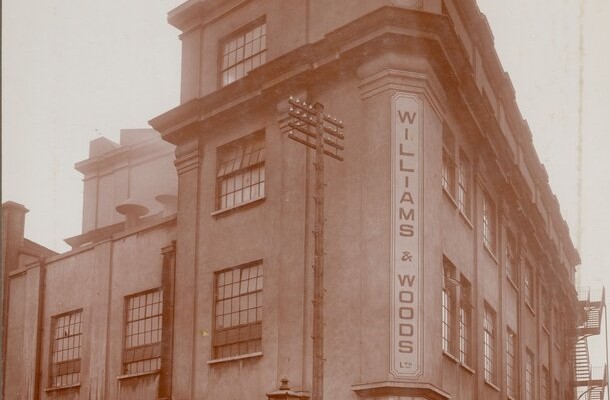Factory Girls: Williams and Woods
StoriesPublished 09 April 2021

14 Henrietta Street is delighted to welcome historian, broadcaster, and curator, Donal Fallon, to write a series of blog posts about the building and its rich and varied history.
Below, Donal explores the legacy of the Williams and Woods Factory and the role it played in the lives of Henrietta Street residents, particularly the many women who worked there.
The Confectionery Boom
The story of Williams and Woods began on the other side of the Liffey, when Henry Williams opened a confectionery shop in Dame Street in the 1850s. Later, together with business partner Robert Woods, his business would become one of the leading employers of women in this area of the city - including the women of Henrietta Street.
In a city where steady employment for female workers was particularly rare, food production factories were an exception to the rule. Major employers included the Jacob’s factory on Bishop Street, the Cadbury’s factory in East Wall and Williams and Woods - which prided itself on jams and marmalades. By the 1890s they had taken up residence at their current location at King’s Inns Street.
The rise of confectionery in these islands in the late nineteenth and early twentieth centuries had real economic impacts on cities like Dublin. As Marjorie Deleuze has noted, "The booming confectionery businesses at the time encompassed different kinds of professions: shop keepers, commercial travelers, sugar boilers, chocolate moulders. Other workers were employed packing and wrapping sweets."
Williams and Woods
The construction of the Williams and Woods factory was undertaken by G & T Crampton, a building company who constructed, “commercial buildings, shops, houses, hospitals, and factories.” Today, a rich visual archive of images from their projects is hosted online by University College Dublin, showing all from the Art Deco housing schemes of Herbert Simms, to ball alleys in new suburbia. However, it’s fair to say nothing matched the Williams and Woods premises in scale.
The prestigious standing of the company is evident from their very active role in public life - there was a Williams and Woods exhibition at the enormous Irish International Exhibition in 1907, a celebration of Irish industry which drew hundreds of thousands of visitors to Herbert Park. There, the crowds munched on "confectionery in the shape of fruits and flowers, made of marzipan", along with "jams, marmalade, candied and drained peel, pickles and sauce." When Queen Victoria arrived in Dublin in 1900, the company provided "one ton of jam and 10,000 bags of sweets" for the Children's Day Victoria hosted in the Phoenix Park, attended by some fifteen thousand children. Not to be undone, Johnston, Mooney and O'Brien provided three thousand buns for the occasion.
Workers and the Easter Rising
At the time of its opening, Williams and Woods employed some 400 workers - the vast majority of them women from the immediate area. Laura Butler, who has done much research on the economic life of the company, notes that in the 1920s milk came from their own herd in North Dublin, while the company also had a fruit farm at Kilsallaghan in County Dublin.
The factory survived the Irish revolution intact. One of the few rebel garrisons who enjoyed a relatively quiet Easter Rising were those in Jacob’s biscuit factory, under the command of Thomas MacDonagh and Major John MacBride. That area - around Bishop Street - proved particularly hostile to the rebels, as many of the women locally worked in Jacob’s and had loved ones fighting in the war. Late in the Rising, a plan was devised to seize Williams and Woods factory by the leaders of the GPO Garrison, believing that its solid concrete exterior would offer defence, and that they could later link up with the Four Courts garrison. This plan never came to fruition, owing to the intense fighting in the Moore Street area.
Working women
Remarkably, a thousand workers called Williams and Woods home by the middle of the twentieth century. No longer were they producing merely W&W branded goods, but Crosse and Blackwell and Chef products. Toblerones, fruit pastilles, wine gums and Silvermints were all produced here, leading to a number of smells as familiar to the residents of the surrounding streets as stout is to those who live in the Liberties. One of the more unusual products from the factory was the Irish Coffee Bar - containing whiskey.
By the 1970s, there was an exodus of factories from Dublin’s inner-city. Familiar names like Jacob’s and Williams and Woods, along with Cadbury’s and more, made for new settings in places like Coolock and Tallaght. The impressive factory building - still bearing the historic name of Williams and Woods - became a creative arts centre, cafe and more with the establishment of The Chocolate Factory in 2012.
In his history of the women of Dublin's tenements, Kevin Kearns wrote about how, "needy mothers were glad to accept a job in the like of Polikoff's tailoring factory, Donnelly's Bacon, Mooney's Sack, Mitchell's Rosary Beads, Mount Brown Laundry, Lever Brothers' Soap, Afton Knitting, Carroll's Tobacco, Wilton's Confectionery, Winstanley's Shoes, Burton's Sewing, or even an ammunition factory in Parkgate Street."
While all of these names were to be found on the wage slips of Dublin’s female workers - in this part of the city, the name of Williams and Woods was most important.
Donal Fallon
Donal Fallon is a historian, broadcaster and curator from Dublin. Formerly Historian in Residence to Dublin City Council, he is the author of numerous studies of twentieth century Dublin, including The Pillar: The Life and Afterlife of the Nelson Pillar (New Island, 2013). He produces the Three Castles Burning podcast and has contributed to publications including Jacobin, Dublin Historical Review, Saothar and The Irish Times. He is a graduate of Maynooth University, University College Dublin and the Ulster University, and lectures with the Lifelong Learning department of University College Dublin.
 ShopBook Now
ShopBook Now